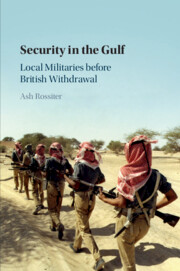Book contents
- Security in the Gulf
- Security in the Gulf
- Copyright page
- Contents
- Preface
- Abbreviations
- Introduction
- 1 Patterns of Protection in the Gulf
- 2 British India and Local Security Arrangements
- 3 Local Militaries and Intensified British Interests
- 4 Intervention or Local Means of Coercion?
- 5 Local Forces and Britain’s Silver Age in the Gulf
- 6 Securing the Gulf after Britain’s Withdrawal
- Conclusion
- References
- Index
2 - British India and Local Security Arrangements
Published online by Cambridge University Press: 15 June 2020
- Security in the Gulf
- Security in the Gulf
- Copyright page
- Contents
- Preface
- Abbreviations
- Introduction
- 1 Patterns of Protection in the Gulf
- 2 British India and Local Security Arrangements
- 3 Local Militaries and Intensified British Interests
- 4 Intervention or Local Means of Coercion?
- 5 Local Forces and Britain’s Silver Age in the Gulf
- 6 Securing the Gulf after Britain’s Withdrawal
- Conclusion
- References
- Index
Summary
In the years following World War I, the British Government of India began taking greater interest in internal security challenges in the Gulf. Aside from small detachments of sepoys in Manama and Muscat, Britain did not have forces stationed in the area to prevent plots against rulers or defend against unexpected tribal attacks from the desert. There were very few incentives for Britain to fill this power gap by garrisoning troops, but plenty of disincentives: hostile inhabitants, an unforgiving climate in summer and malaria in winter. In keeping with its hands-off approach, Britain wanted the rulers to secure their own positions by developing militaries. In Muscat, the British actively encouraged the sultan to develop a force that could dominate the land approaches to Muscat. Britain supported the establishment of the Bahrain Levy Corps in 1924 to protect the regent from relatives. In Kuwait, the threat was external: raids by the Ikhwan (religiously inspired tribal fighters) into Kuwaiti territory. In all cases, the British Government of India wanted the local rulers to take greater responsibility for securing their own territories rather than continually seeking British military assistance in a crisis.
- Type
- Chapter
- Information
- Security in the GulfLocal Militaries before British Withdrawal, pp. 23 - 68Publisher: Cambridge University PressPrint publication year: 2020

